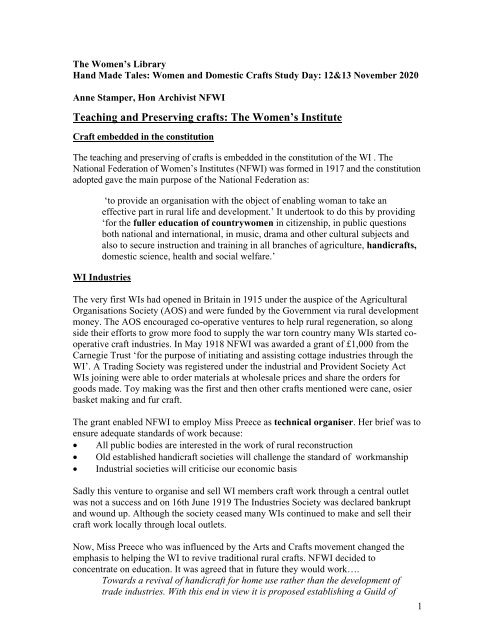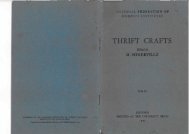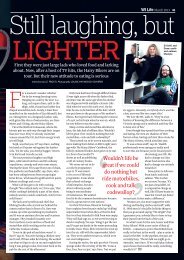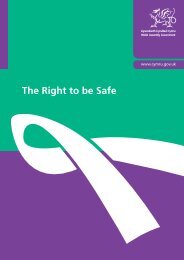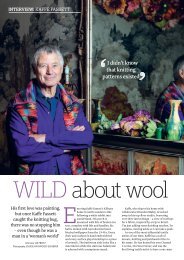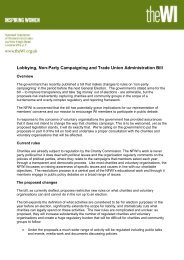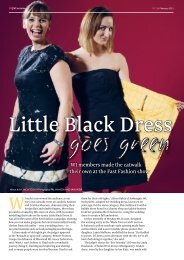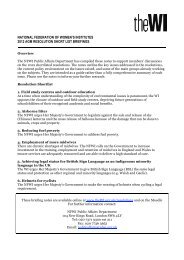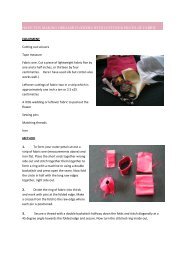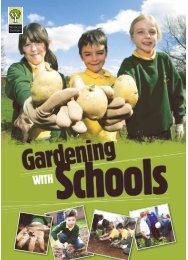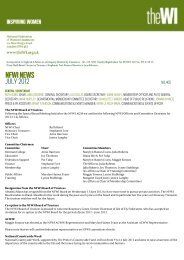Teaching and Preserving crafts - National Federation of Women's ...
Teaching and Preserving crafts - National Federation of Women's ...
Teaching and Preserving crafts - National Federation of Women's ...
Create successful ePaper yourself
Turn your PDF publications into a flip-book with our unique Google optimized e-Paper software.
The Women’s Library<br />
H<strong>and</strong> Made Tales: Women <strong>and</strong> Domestic Crafts Study Day: 12&13 November 2020<br />
Anne Stamper, Hon Archivist NFWI<br />
<strong>Teaching</strong> <strong>and</strong> <strong>Preserving</strong> <strong>crafts</strong>: The Women’s Institute<br />
Craft embedded in the constitution<br />
The teaching <strong>and</strong> preserving <strong>of</strong> <strong>crafts</strong> is embedded in the constitution <strong>of</strong> the WI . The<br />
<strong>National</strong> <strong>Federation</strong> <strong>of</strong> Women’s Institutes (NFWI) was formed in 1917 <strong>and</strong> the constitution<br />
adopted gave the main purpose <strong>of</strong> the <strong>National</strong> <strong>Federation</strong> as:<br />
‘to provide an organisation with the object <strong>of</strong> enabling woman to take an<br />
effective part in rural life <strong>and</strong> development.’ It undertook to do this by providing<br />
‘for the fuller education <strong>of</strong> countrywomen in citizenship, in public questions<br />
both national <strong>and</strong> international, in music, drama <strong>and</strong> other cultural subjects <strong>and</strong><br />
also to secure instruction <strong>and</strong> training in all branches <strong>of</strong> agriculture, h<strong>and</strong>i<strong>crafts</strong>,<br />
domestic science, health <strong>and</strong> social welfare.’<br />
WI Industries<br />
The very first WIs had opened in Britain in 1915 under the auspice <strong>of</strong> the Agricultural<br />
Organisations Society (AOS) <strong>and</strong> were funded by the Government via rural development<br />
money. The AOS encouraged co-operative ventures to help rural regeneration, so along<br />
side their efforts to grow more food to supply the war torn country many WIs started cooperative<br />
craft industries. In May 1918 NFWI was awarded a grant <strong>of</strong> £1,000 from the<br />
Carnegie Trust ‘for the purpose <strong>of</strong> initiating <strong>and</strong> assisting cottage industries through the<br />
WI’. A Trading Society was registered under the industrial <strong>and</strong> Provident Society Act<br />
WIs joining were able to order materials at wholesale prices <strong>and</strong> share the orders for<br />
goods made. Toy making was the first <strong>and</strong> then other <strong>crafts</strong> mentioned were cane, osier<br />
basket making <strong>and</strong> fur craft.<br />
The grant enabled NFWI to employ Miss Preece as technical organiser. Her brief was to<br />
ensure adequate st<strong>and</strong>ards <strong>of</strong> work because:<br />
• All public bodies are interested in the work <strong>of</strong> rural reconstruction<br />
• Old established h<strong>and</strong>icraft societies will challenge the st<strong>and</strong>ard <strong>of</strong> workmanship<br />
• Industrial societies will criticise our economic basis<br />
Sadly this venture to organise <strong>and</strong> sell WI members craft work through a central outlet<br />
was not a success <strong>and</strong> on 16th June 1919 The Industries Society was declared bankrupt<br />
<strong>and</strong> wound up. Although the society ceased many WIs continued to make <strong>and</strong> sell their<br />
craft work locally through local outlets.<br />
Now, Miss Preece who was influenced by the Arts <strong>and</strong> Crafts movement changed the<br />
emphasis to helping the WI to revive traditional rural <strong>crafts</strong>. NFWI decided to<br />
concentrate on education. It was agreed that in future they would work….<br />
Towards a revival <strong>of</strong> h<strong>and</strong>icraft for home use rather than the development <strong>of</strong><br />
trade industries. With this end in view it is proposed establishing a Guild <strong>of</strong><br />
1
Learners which shall have as its object to improve the conditions <strong>of</strong> rural life by<br />
encouraging home <strong>and</strong> local industries. i<br />
The Guild <strong>of</strong> Learners <strong>of</strong> Home Craft was launched in February 1920 at a conference<br />
<strong>of</strong> WI County H<strong>and</strong>icraft Organisers in London. It was reported that<br />
The feeling <strong>of</strong> the meeting was firm upon the need for securing a good st<strong>and</strong>ard,<br />
the advantage <strong>of</strong> linking up those who wished to excel in h<strong>and</strong><strong>crafts</strong> <strong>and</strong> the great<br />
ability <strong>of</strong> country women in this direction ii<br />
In due course NFWI received grant aid for this work from the Development Commission<br />
<strong>and</strong> Miss Preece continued to be employed , she explained:<br />
As distinct from industries, which were primarily connected with money-making,<br />
h<strong>and</strong>i<strong>crafts</strong> had as their first essential enjoyment in the work for its own sake. In<br />
industry, capital, premises, <strong>and</strong> trade conditions had to be considered. In<br />
h<strong>and</strong>i<strong>crafts</strong> we worked in our homes, supplied our own good material, instead <strong>of</strong><br />
buying ready made, bad <strong>and</strong> expensive, <strong>and</strong> we revived the old <strong>crafts</strong> for which<br />
Englishwomen were once famous all over the world. iii<br />
The Guild <strong>of</strong> Learners purpose was to regain the practice <strong>of</strong>:<br />
1) Home h<strong>and</strong>i<strong>crafts</strong> with a view to restoring the best traditions <strong>of</strong> English<br />
Workmanship<br />
2) To assist in bringing the best instruction in h<strong>and</strong>i<strong>crafts</strong> within the reach <strong>of</strong><br />
villages.<br />
The Membership was in two categories:<br />
1. Associates – WI members who will undertake to become pr<strong>of</strong>icient in some<br />
h<strong>and</strong>icraft connected with the home<br />
2. Members<br />
a) WI members who are already pr<strong>of</strong>icient in some h<strong>and</strong>icraft<br />
b) WI members who are pr<strong>of</strong>icient in some h<strong>and</strong>icraft <strong>and</strong> are willing to use the<br />
knowledge for the furtherance <strong>of</strong> such craft in their neighbourhood<br />
A series <strong>of</strong> pr<strong>of</strong>iciency tests were gradually introduced which a member had to complete<br />
before she could train as a demonstrator, instructor or judge. The first test was held in<br />
September 1920 <strong>and</strong> it was for glove making.<br />
Once established the main services <strong>of</strong>fered by the Guild centrally were:<br />
• The Guild Library<br />
• Loan collection <strong>of</strong> specimens <strong>of</strong> craft work<br />
• Advice on technical points<br />
• Schools for training <strong>of</strong> demonstrators, teachers <strong>and</strong> judges<br />
• Administering tests<br />
The first national course to be organised by the H<strong>and</strong>icraft sub-committee was a five day<br />
course in September 1920 at The Victoria <strong>and</strong> Albert Museum. The subject was<br />
2
Decorative Stitchery <strong>and</strong> included lectures from V&A staff, visits to exhibits <strong>and</strong> the<br />
library.<br />
The History <strong>of</strong> Ornament – Pr<strong>of</strong> Newberry<br />
Chinese symbolism<br />
Dress embroidery for present time – Miss Drew<br />
Embroideries seen in Czecho-Slovakia – Miss Drew<br />
Banners – Comm<strong>and</strong>er Kettlewell<br />
H<strong>and</strong>work as the basis <strong>of</strong> civilisation – Miss Preece<br />
The Guild <strong>of</strong> Learners first priority was to train <strong>and</strong> appoint leaders who would become<br />
the teachers, trainers <strong>and</strong> demonstrators for the WI members throughout the country.<br />
One <strong>of</strong> the first Schools was held in November 1920 at the Technical Institute in<br />
Tunbridge Wells. 32 members attended this course which lasted 12 days. The students<br />
could select from: glove making, upholstery (they made pouffes), carpentry (bowls, trays,<br />
boxes <strong>and</strong> even a bookcase were produced) <strong>and</strong> fur craft “poor little bunny skins so nasty<br />
<strong>and</strong> fatty developed into wonderful fur gloves” iv<br />
‘Pr<strong>of</strong>iciency tests were organised in glove making, decorative stitching, basket work <strong>and</strong><br />
rush work. For example:<br />
Decorative stitching (also called embroidery) a c<strong>and</strong>idate had to provide:<br />
1. An article <strong>of</strong> wearing apparel for the child or grown up, such as<br />
embroidered frock, tunic, jumper, blouse etc.<br />
2. A piece <strong>of</strong> embroidery for the home on linen<br />
3. Optional<br />
35 c<strong>and</strong>idates, 23 passed, 10 failed, 2 disqualified.<br />
Colour <strong>and</strong> design were criticised ‘some excellent stitchery was spoilt on poor<br />
designs<br />
High st<strong>and</strong>ards were set, <strong>and</strong> these certificates were worth getting It was the beginning <strong>of</strong><br />
the reputation reflected in the saying ‘…but is it up to WI st<strong>and</strong>ards?’ v<br />
A report on first year <strong>of</strong> the Guild was given in July 1921,<br />
209 members, 82 holding ‘A’ certificates for their craft <strong>and</strong><br />
7 the ‘B’ certificate as well.<br />
Crafts;<br />
34 Basket <strong>and</strong> rush workers; 86 glovemakers; 52 embroiderers; 16 upholsterers; 8<br />
furcraft-workers; 6 weavers <strong>and</strong> spinners; 5 lace-makers; 7 Chair-caners; 4 toysmakers;<br />
4 vegetable dyers; 3 book binders; 4 cobblers; 3 carpenters; 4<br />
dressmakers; 3 knitters; 9 plain needle-workers; 1 potter; 1 slipper maker; 2<br />
woodcarvers.<br />
In 1921 it was decided to introduce two versions <strong>of</strong> the B certificate- 1st <strong>and</strong> 2nd class -<br />
acknowledging that different skills were required for teaching <strong>and</strong> demonstrating. A<br />
good teacher for a small class may not be good at giving a talk <strong>and</strong> demonstration to a<br />
large group. 1st class would be awarded to someone who could both teach <strong>and</strong><br />
demonstrate. vi A Guild <strong>of</strong> Learners Badge was introduced with a ribbon to hold the<br />
‘bars’ for each pr<strong>of</strong>iciency certificate awarded (there are examples in the archives)<br />
3
The qualified tutors travelled round the country teaching groups <strong>of</strong> WI members many <strong>of</strong><br />
whom lived in remote villages <strong>and</strong> had never had access to adult education classes<br />
before. They were happy to display their work for group photographs<br />
The residential schools<br />
As well as classes NFWI organised intensive residential schools – for example in 1921-<br />
the ‘Dorset Pioneer H<strong>and</strong>icraft School’, lasted two weeks <strong>and</strong> <strong>of</strong>fered tuition in, basket<br />
making, cane <strong>and</strong> rush seating, cobbling, chamois <strong>and</strong> fur glove making, thrift rugs,<br />
decorative stitchery, smocking, slipper making <strong>and</strong> upholstery. 120 ‘pupils took lessons<br />
<strong>and</strong> had to pass tests six months after having received instruction before they were finally<br />
accepted as instructors’ <strong>and</strong> 32 become teachers’.<br />
<strong>Teaching</strong> <strong>crafts</strong> to all members<br />
Local classes<br />
Many <strong>of</strong> the WI trained teachers started to work for the local authorities <strong>and</strong> there was a<br />
dem<strong>and</strong> for more WI teachers. In 1925 NFWI received a further grant to employ an<br />
assistant h<strong>and</strong>icraft organiser to visit federations in order to check on the students who<br />
were trained, free, by the Guild <strong>of</strong> Learners <strong>and</strong> ensure that they ‘should furnish accurate<br />
yearly returns <strong>of</strong> their work’.<br />
In 1927 NFWI received ‘a grant from the Development Commission for the h<strong>and</strong>icraft<br />
department to train teachers – the education authorities in most counties being as yet<br />
unable to provide all that is required in that respect’. A block grant <strong>of</strong> £1,665 was given<br />
to provide grants to County <strong>Federation</strong>s who ‘undertake to hold 5-day schools in a craft<br />
not previously taught in the area’. Reports <strong>of</strong> such schools include teaching embroidery,<br />
s<strong>of</strong>t furnishing, upholstery, book-casing, cane-seating, eiderdown making, gloving, lacemaking,<br />
linen embroidery, smocking, s<strong>of</strong>t-toy making, tinkering. New <strong>crafts</strong> introduced<br />
included crochet <strong>and</strong> carpet mending.<br />
Publications<br />
For WI members who did not belong to the Guild <strong>of</strong> Learners Home <strong>and</strong> Country(the<br />
WI monthly magazine) carried a regular column <strong>and</strong> articles on H<strong>and</strong>icraft. In 1922 there<br />
was a series <strong>of</strong> articles - Hints on embroidery by Joan Drew <strong>and</strong> the first paper patterns<br />
were introduced that could be ordered from the magazine<br />
There were also booklets <strong>and</strong> many simple <strong>and</strong> cheap leaflets produced by the NFWI<br />
publications department<br />
Local Crafts<br />
There was great interest in reviving local <strong>crafts</strong>: in Somerset <strong>and</strong> Norfolk rushwork, in<br />
Sussex smock making, in Dorset making covered buttons. An unsual one from Cumbria<br />
was making mats from bailer twine.<br />
These were promoted not only locally but nationally <strong>of</strong>ten by printing leaflets or articles<br />
in Home <strong>and</strong> Country<br />
4
Exhibitions<br />
Another way <strong>of</strong> encouraging WI members to improve their craft work was by holding<br />
exhibitions where judges would award marks <strong>and</strong> give comments, these were intended to<br />
be positive <strong>and</strong> give pointers to the ways the work could be improved.<br />
The first national exhibition had been held in 1918 <strong>and</strong> had been primarily for selling<br />
goods the pr<strong>of</strong>it being shared between the maker <strong>and</strong> NFWI. Banners were awarded for<br />
displays.<br />
Many <strong>National</strong> H<strong>and</strong>icraft exhibitions followed increasing in size <strong>and</strong> importance.<br />
Staging <strong>and</strong> display became important <strong>and</strong> training was provided for that. To seect the<br />
items to be shown at the national exhibitions <strong>Federation</strong>s organised their own H<strong>and</strong>icraft<br />
Exhibitions from which the best items were selected<br />
Table to show the national exhibitions held 1920 – 2000<br />
Year Venue comment<br />
1920 Caxton Hall included craft work demonstrations, over £1000<br />
earned by sellers<br />
1921 Victoria <strong>and</strong> small display <strong>of</strong> craft work by the Guild <strong>of</strong><br />
Albert Museum<br />
1922 Victoria <strong>and</strong><br />
Albert Museum<br />
Learners – no sales<br />
652 exhibits from 49 counties <strong>and</strong> 281 exhibits<br />
from individual Guild <strong>of</strong> learners. There were no<br />
sales, no competitions no prizes, its sole purpose<br />
was to display the best h<strong>and</strong>work the movement<br />
could produce<br />
1924 The Drapers Hall included for the first time a section for cooperative<br />
work <strong>and</strong> also a section for cottage<br />
furnishing.<br />
1927 Indian Pavilion <strong>of</strong><br />
the Imperial<br />
Institute<br />
1929 the Imperial<br />
Institute South<br />
Kensington<br />
London <strong>and</strong> the<br />
City Art gallery<br />
in Leeds<br />
1932 New<br />
Horticultural<br />
Halls<br />
1935 New<br />
Horticultural<br />
Halls<br />
1938 New<br />
Horticultural<br />
Halls<br />
<strong>of</strong> the 1,822 exhibits that came from the counties<br />
only 983 were displayed. This was the first year<br />
that gold stars were awarded.<br />
the specially made Queen’s quilt was given to<br />
Queen Mary. There were 1,786 entries, 1,061<br />
were displayed <strong>and</strong> 45 gold stars awarded. It<br />
was estimated that 24,000 people saw the<br />
exhibition in one or other <strong>of</strong> its venues.<br />
County co-operative rooms were introduced <strong>and</strong><br />
every county exhibited.<br />
25,000 people visited in the week it was open.<br />
Exhibits were selected from entries from 57<br />
County <strong>Federation</strong>s<br />
Ran for 8 days Admission members (wearing a<br />
badge) 1/6, none members 2/6<br />
Arrangements made with the railway companies<br />
for visitors to the exhibition to make a one day<br />
5
visit to London for a single fare<br />
1946 Leamington Spa Craftswomen at work. It consisted <strong>of</strong> continuous<br />
practical demonstrations<br />
1952 Victoria <strong>and</strong><br />
Albert Museum<br />
H<strong>and</strong>i<strong>crafts</strong> in the home. 41,500 visited. Centre<br />
piece was the wall hanging Women in Wartime<br />
now at the Imperial War Museum.<br />
1960 Victoria <strong>and</strong> The Country Year<br />
Albert Museum<br />
1965 Ceylon Tea<br />
Centre<br />
The Countrywoman Today a general exhibition<br />
including <strong>crafts</strong> to celebrate golden jubilee<br />
1975 Commonwealth Tomorrow’s Heirlooms 52,232 attended<br />
Institute<br />
2000 Tatton Park Millennium Craft Spectacular<br />
1930s <strong>and</strong> the Depression<br />
In the 1930s with the support <strong>of</strong> a grant from The Development Commission NFWI could<br />
continue to employ a H<strong>and</strong>i<strong>crafts</strong> Organiser/Adviser. However funding was not as<br />
generous <strong>and</strong> no longer gave free tuition for lecturers <strong>and</strong> demonstrators <strong>and</strong> new<br />
training was introduced for judges <strong>and</strong> for those involved in staging <strong>and</strong> design<br />
More emphasis was given to ways <strong>of</strong> supporting the craft tutors with such things as the<br />
loan collections which were enlarged <strong>and</strong> kept up to date; there were special collections<br />
for teachers <strong>of</strong> specific <strong>crafts</strong> to borrow as well as the general collections to be used to<br />
promote craft work. <strong>Federation</strong>s also put together their own loan collections, <strong>and</strong> still do<br />
to this day.<br />
In 1934 NFWI received a grant from the government ‘to assist in the teaching <strong>of</strong> <strong>crafts</strong> in<br />
Occupational Centres for the unemployed’ NFWI published a very popular booklet on<br />
Thrift <strong>crafts</strong>.<br />
War time<br />
During the Second World War, with materials in short supply, the H<strong>and</strong>icraft work<br />
concentrated on ‘make do <strong>and</strong> mend’, <strong>and</strong> a huge amount <strong>of</strong> knitting <strong>of</strong> socks <strong>and</strong><br />
pullovers for the troops, prisoners <strong>of</strong> war, search light operators, refugees ….<br />
Once the war was over the emphasis reverted once more to teaching <strong>and</strong> raising<br />
st<strong>and</strong>ards. A survey carried out in 1948 showed that the most popular classes in the WIs<br />
were: Dressmaking, Leather work, Basketry, Rugs, Gloves, S<strong>of</strong>t toys, Upholstery,<br />
Quilting, Embroidery.<br />
Denman College – NFWI’s own short stay residential college, Marcham near<br />
Oxford<br />
The opening <strong>of</strong> the college in 1948 gave a whole new dimension to craft work. There<br />
were two types <strong>of</strong> course in the early years, ‘A’ courses open to any WI member, <strong>and</strong> ‘B’<br />
course which were only open to members nominated by their <strong>Federation</strong>, <strong>and</strong> these were<br />
training courses many <strong>of</strong> which were in Craft subjects. From the beginning about a<br />
6
quarter <strong>of</strong> the courses were craft. In the 1950s the popular ‘Country Housewife’ courses<br />
included some craft work, but there were also specialist craft subjects, e.g.<br />
1951 Upholstery, Linen embroidery, the making <strong>of</strong> underclothes,<br />
1952 Upholstery, s<strong>of</strong>t furnishing, smocking, gloving, fabric printing, cross-stitch<br />
1955 loose covers, lampshades, recovering eiderdowns, basketry, machine<br />
knitting, tatting<br />
1956 sewing new fabrics, pottery, tailoring<br />
At first the craft courses were taught in some renovated huts left by the war Ministry on<br />
the grounds. It was not until 1970 that the new teaching centre provided fully equipped<br />
craft rooms for ‘s<strong>of</strong>t’ <strong>and</strong> ‘hard’ <strong>crafts</strong>.<br />
Individual federations furnished the bedrooms <strong>and</strong> this resulted in some beautiful craft<br />
work – patchwork bedspreads etc<br />
In the 1950s the ‘Guild <strong>of</strong> Learners <strong>of</strong> h<strong>and</strong>i<strong>crafts</strong>’ change its name to The H<strong>and</strong>icraft<br />
Guild – but continued to administer Pr<strong>of</strong>iciency test - A B <strong>and</strong> C tests (C for teachers)<br />
The list <strong>of</strong> <strong>crafts</strong> now included clothes renovation <strong>and</strong> machine work <strong>and</strong> mending <strong>and</strong><br />
upholstery.<br />
In 1966 Correspondence courses were started by NFWI as a way <strong>of</strong> helping WI<br />
members to learn a new craft even if they were not able to find a local class. The first <strong>of</strong><br />
these were: canvass work, patchwork, basketry <strong>and</strong> embroidery. The work could be sent<br />
to a tutor for comment <strong>and</strong> advice.<br />
Design Award<br />
Various craft advisers over the years had commented on the importance <strong>of</strong> design in craft<br />
work <strong>and</strong> finally in 1967 A new award for work having special merit by showing all<br />
round high st<strong>and</strong>ard <strong>of</strong> design was announced, to start in 1968. Called the Design Award<br />
it was initially given for any piece <strong>of</strong> craft work that had been entered for one <strong>of</strong> the<br />
H<strong>and</strong>icraft Guild tests. The first three were given in 1969 for crochet, tatting <strong>and</strong> rug<br />
making. In 1973 the procedures changed <strong>and</strong> items were submitted directly for the<br />
award.<br />
End <strong>of</strong> the Guilds<br />
The H<strong>and</strong>icraft Guild was abolished (along with the Produce Guild) in 1972. It was<br />
argued that the work <strong>of</strong> the two Guilds was central to the aims <strong>of</strong> the whole <strong>of</strong><br />
organisation <strong>and</strong> every member should have access to this without further payment. It<br />
was replaced by the Home Economics department incorporating both areas <strong>of</strong> work.<br />
In 1977 the Home Economics Basic Certificates replaced the ‘pr<strong>of</strong>iciency tests. A<br />
modern syllabus was produced <strong>and</strong> the c<strong>and</strong>idates had to submit for examination not only<br />
the required craft items but also a ‘working notebooks’. In 1978 252 certificates were<br />
awarded <strong>and</strong> the Design award was given to 7 members from 39 entries.<br />
It was not until 1977, with the formation <strong>of</strong> WI Books Ltd that a new era <strong>of</strong> publishing<br />
began. Proper hardback books, rather than pamphlets, were produced <strong>and</strong> aimed at the<br />
general public as well WI members, <strong>and</strong> with the aim not only <strong>of</strong> education but also <strong>of</strong><br />
7
making a pr<strong>of</strong>it for NFWI. WI Books ceased to trade as a separate company when it no<br />
longer was pr<strong>of</strong>itable at the end <strong>of</strong> the 1990s<br />
Sponsorship<br />
In the late 1970s, as grants from the Government were reduced, NFWI began to make<br />
links with commercial sponsors. In 1979 the Design award was run in association with<br />
the British Wool Marketing Board. The East Sussex member who won was able to see<br />
her design modelled on the cat walk at a fashion show.<br />
Modern times<br />
A third <strong>of</strong> the courses at Denman College continue to be in craft work although they<br />
reflect changing interests amongst members – there is an increase in ‘hobby <strong>crafts</strong>’<br />
decoupage, encaustic art, quilling, covered boxes.<br />
In the 1990s ‘Action Packs’ were developed. Devised by specialist craft advisers these<br />
packs enable a group to learn a skill without a tutor, following step by step instructions.<br />
Travelling tutors provided another way in which WIs could get tuition in some <strong>of</strong> the<br />
more specialist <strong>crafts</strong> where they might not find a class locally.<br />
In the 1990s there was also a policy <strong>of</strong> seeking external accreditation for the<br />
qualifications <strong>of</strong>fered through NFWI. Accreditation was sought through the Open<br />
College Network, which also enabled Denman College to access funding via a franchise<br />
with Abingdon College. In craft work in particular NFWI built up a relationship with<br />
City <strong>and</strong> Guilds. For example a City <strong>and</strong> Guilds certificates in embroidery <strong>and</strong> patchwork<br />
<strong>and</strong> quilting. NFWI also <strong>of</strong>fers the C&G 7900 Creative Skills scheme. As with the<br />
qualifications through the Guild <strong>of</strong> Learners in the 1920s <strong>and</strong> 1930s it is only a small<br />
number <strong>of</strong> people who take these, but they are important as the teachers <strong>of</strong> the future.<br />
------------------------------------------------------------------------------------------<br />
In NFWI archives at the Women’s Library<br />
Design Award 1968 – 1999<br />
FWI/B/2/2/125<br />
Crafts in the 1920<br />
FWI/H/42<br />
Original designs in craft work by members <strong>of</strong> WI 1972 pamphlets <strong>and</strong> notes<br />
FWI/E/4/2/18<br />
NFWI Loan Collection 1961-1981<br />
FWI/E/4/2/20<br />
Life <strong>and</strong> Leisure Community Quilts 1984<br />
FWI/E/4/2/29 <strong>and</strong> 30<br />
Status <strong>of</strong> Guilds 1925-1974<br />
FWI/E/4/2/32<br />
Guilds origin <strong>and</strong> cessation<br />
FWI/E/4/2/34<br />
Books on H<strong>and</strong>i<strong>crafts</strong><br />
FWI/G/1/3/3 & 3/1 Needlecraft<br />
Thesis<br />
Public Face <strong>and</strong> Private Space<br />
8
The <strong>crafts</strong> in Britain between the wars – Thesis by Jacqueline Barber 1998<br />
FWI/H/33<br />
Bibliography<br />
Connell, Linda <strong>and</strong> Stamper, Anne, Textile Treasures <strong>of</strong> the WI, <strong>National</strong><br />
Needlework Archive, 2007<br />
Dudgeon, Piers, Village Voices, WI Books 1989<br />
Garner, Gwen, Extraordinary Women, WI Books 1995<br />
Goodenough, Simon, Jam <strong>and</strong> Jerusalem, Collins 1977<br />
Jenkins, Inez, The History <strong>of</strong> the Women’s Institute Movement <strong>of</strong> Engl<strong>and</strong> <strong>and</strong><br />
Wales, Oxford 1953<br />
Jennings, Paul, The Living Village, Hodder <strong>and</strong> Stoughton 1968<br />
Stamper, Anne, Rooms <strong>of</strong>f the Corridor, Education in the WI <strong>and</strong> 50 years <strong>of</strong><br />
Denman College 1948-1998, WI Books 1998<br />
i NFWI executive committee minutes <strong>of</strong> 9/12/1919<br />
ii Home & Country March 1920<br />
iii H&C May 1920 p13<br />
iv Home <strong>and</strong> Country Jan 1921 p7<br />
v This was the title given to a dissertation written by Joanne Pearce for a History <strong>of</strong> Design BA, Brighton<br />
University in 1998<br />
vi H&C Nov 1921 p5<br />
9


